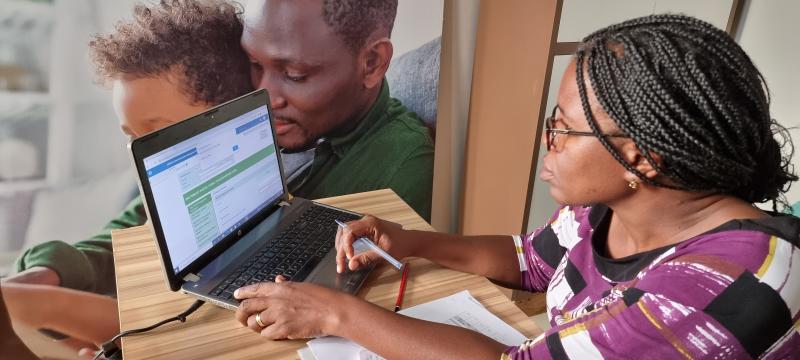
The Ministry of Education and Sports (MoES), Basic Education Department in collaboration with HISP Uganda and Save the Children Uganda have been implementing the DHIS2-DEMIS project since June 2019 with support from Norad. In 2020, funding from GPE KIX led to expansion from Gulu and Mayuge to the districts of Wakiso and Ntungamo.
The implementation of DHIS2 as a decentralized education management information system (EMIS) has focused on building the capacity of districts to collect, capture, validate, analyze, and use data for budgeting, planning, and resource distribution including the allocation of student capitation grants. DHIS2- DEMIS provides user-friendly analytics tools, including dashboards for easy presentation of key education indicators such as enrolment by gender and pupil-teacher and pupil-classroom ratios, which inform decision making at the district level.
Before the introduction of DHIS2, the EMIS in Uganda was centralized at the Ministry of Education and Sports (MoES) with a stand-alone database and a largely manual data management process. Data collected through the annual statistical census was captured into EMIS at the MoES central level offices, analyzed, and presented in statistical yearbooks with 6-9 months’ time lag. The system was neither accessed by the district offices nor linked to other MoES systems e.g. finance, HR, examination, nor to other cross-cutting sectors like health. The annual statistical census was last conducted in 2017. This meant that the MoES and districts lacked timely and reliable data to inform planning and resource allocation.
To circumvent these challenges, different MoES departments and education development partners (EDPs) conducted frequent ad hoc data calls to districts and schools. These data calls were uncoordinated across departments and EDPs, often times requesting different categorization of the same data elements (e.g. total enrolment or enrolment disaggregated by sex, or enrolment disaggregated by sex and class) thus causing data collection fatigue of district education managers. Sometimes the districts did not use the templates provided and shared the data in different formats (e.g. word, excel, PDF) leading to further delays in analysis and feedback to the districts.
Learning from over 10 years of implementing DHIS2 in the health sector in Uganda, a key lesson for the KIX research project is that harmonization of data collection, reporting tools and partners needs is key to successful joint implementation and scale. This has not been the case in the education sector, where different MoES departments and partners’ tools are not harmonized. A need was identified to streamline, integrate, and routinize data collection efforts by different MoES departments, districts, and partners to inform planning and resource allocation at both the central and district levels. Therefore, routine reporting using the newly developed integrated termly data collection tool will improve coordination, analysis, and presentation of the different indicators across departments for improved data use.
Process
HISP Uganda and Save the Children Uganda conducted a one-week data and DHIS2 customization workshop for MoES user departments and partners. These included the Gender unit, Guidance and Counseling, HIV & School Health, School Feeding Programme, ICT, Statistics & Planning, Human Resources, Higher Education, and Teacher Instruction Education Training, as well as partners such as Plan International, PlayMatters and War Child Holland. Teams shared key indicators and data needs which were reviewed, documented, and harmonized into draft pre-primary and primary termly reporting tools. Feedback from the MoES and district stakeholders were incorporated, with a clear message to decrease the volume of data to be collected on a termly basis.
With the decline in COVID-19 cases and full re-opening of the economy, the team held a one-day stakeholder review workshop with the different user departments and district education team. Feedback from the workshop was incorporated into the tools that were used for field testing at selected schools in Wakiso district. The field-testing exercise clearly highlighted the data elements that could be challenging to collect on a termly basis and which elements needed to be clearly defined for ease in data capture. The finalized data collection tools have been customized in the DHIS2-DEMIS system with support from the MoES departmental staff that had exhibited capacity to do system customization based on their performance results in the customization workshop. This builds on one of the project’s objectives of building the capacity of MoES staff to sustainably run the system and be able to update it based on new data needs that arise.
The team trained district inspectors of schools and field tested the DHIS2-DEMIS system for data capture and entry using both the android and web versions at different schools. This was in the bid to allow schools with the required resources like internet and computers to be able to capture data at the school level instead of submitting paper tools to the district.
Data use at District Level
Dashboards have been developed in DHIS2 to visualize termly data for each of the implementing sites and the team plans to develop departmental/programme specific dashboards focused on particular indicators on gender, school feeding, school health etc. The programme specific dashboards are also being used as an advocacy tool for engaging more partners like World Food Programme and the Education Response Plan (ERP) for Refugees and Host Communities to support scale and promote data use beyond the project supported districts.
Moving forward, district and Ministry teams have agreed that data should be collected at the end of the first month of each school term after enrolment has stabilized. Further data use workshops have been planned for both the MoES and district education teams to ensure that routine data collected in DHIS2-DEMIS is effectively utilized for planning and decision making. Capacity building will be ongoing through DHIS2 Academies that include topics on Designing for Data Use and Data Analysis and Use. Read more about how the DHIS2 Academy programme aims to strengthen national and regional capacity to successfully set up, design, and maintain DHIS2 systems.
